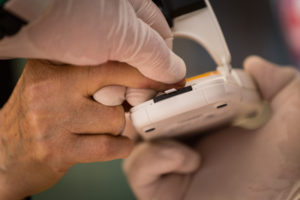On World Diabetes Day Amel Association International releases a Q&A fact sheet
What is it?
Diabetes is a chronic disease that occurs when the pancreas is unable to produce insulin, a crucial hormone that transforms glucose into energy, allowing its absorption. The lack of insulin raises sugar levels in the blood. The consequences include cardiovascular problems, infections and permanent organ and tissue damage or failure.
So why does it matter?
Well, it matters because diabetes causes 4 million deaths worldwide, most of which would be preventable by following a healthy lifestyle – by eating well and doing exercise. There are of course people who suffer the disease due to genetic reasons, but these are a minority. We are talking about a lifetime disease, one that cannot be cured but only treated once diagnosed. The International Diabetes Federation estimates that around 425 million people worldwide were living with the disease in 2017. That number is expected to rise to 629 million by 2045.
Give me more data…
The disease can be widely seen as a non-communicable epidemic, one that has increased uncontrollably in the past 30 years due to poor lifestyle habits. It is especially prevalent in people between the ages of 40 and 59. Patients with diabetes require constant monitoring and regular diagnostic tests – including HBA1C (which measures average glucose levels in blood for the past 2-3 months), kidney function tests and lipid profiles. All these are necessary to avoid irreversible complications.
As such, diabetes treatment causes an annual expenditure of 727 billion dollars worldwide. This is a huge burden to national healthcare systems, especially those in low to middle-income countries, for 79% of all cases worldwide are located there. In 2017, 39 million people of the 425 million diagnosed around the globe were in the Middle East and North Africa.
In Lebanon in particular, 585,000 adults currently live with diabetes. That means 14% of the entire population. It is estimated that a further 251,000 people in the country remain undiagnosed. These figures are not to be taken lightly.

Tell me about the ‘Types’
- Type 1 is an auto-immune reaction that attacks the cells that generate insulin. Daily insulin shots are needed to maintain glucose levels in the body. It is usually diagnosed at a young age.
- Type 2 represents 90% of all diabetes cases, associated with insulin deficiency levels and insulin resistance. This kind of diabetes is exasperated through unhealthy living habits – overweight and obesity are known causes of the disease.
- Gestational diabetes (GDM) concerns high glucose levels in pregnant women. While it disappears after pregnancy, mothers and babies are at more risk of developing Type 2 diabetes later in their lives. 1 in every 25 pregnant women are diagnosed with GDM.
Help me identify warning signs
- Common symptoms for both Type 1 and Type 2 include extreme thirst and dry mouth, frequent urination, lack of energy, high levels of fatigue and blurred vision.
- For Type 1 only, watch out for sudden weight loss, constant hunger and bedwetting, especially in children.
- For Type 2 diabetes, other signs will be tingling or numbness in hands and feet, fungal infections that keep coming back and slow healing wounds.
What can I do?
Spreading awareness on the devastating consequences of diabetes is half the battle won. Diabetes is often times imperceptible and can be diagnosed years after the first symptoms arise. To help yourself, follow a healthy lifestyle. Eat well, do regular exercise and watch your sugar intake. Encourage others to do the same. Luckily, Lebanon’s healthy Mediterranean diet is very good to prevent diabetes. If you experience any of the symptoms mentioned above speak to your doctor.
Why are NGO’s like Amel involved?
Development and humanitarianism is not only about addressing healthcare emergencies. It is also about tackling chronic diseases that would not appear to be critical at first sight. Non-communicable diseases kill 41 million people every year, accounting for 71% of all deaths worldwide. So, they are critical and treating diabetes is a key aspect of promoting accessible healthcare to everyone.
How is Amel contributing?

Amel’s project ‘Managing Diabetes for Older People’, in partnership with HelpAge International, started in September 2017 and is expected to continue until December 2019. The aim is to enhance access to diabetes screening, treatment, referral and prevention care for older men and women with Type 2 diabetes or who are at risk of developing it. The programme also coordinates awareness and educational campaigns on the disease.
From January to July 2018, 2306 beneficiaries at Amel’s centres were screened in Ersal, El Ain and Kamed el Loz. Furthermore, a total of 695 patients suffering from Type 2 diabetes ,(an overwhelming majority of them with co-morbidities, in other words, other associated diseases) were supported across Hay El Sellom, Kamed el Loz, El Ain, Sour and Ersal centres.
Amel also conducts psycho-social support activities for people at risk of developing diabetes. These include crochet and swing, games and chess, sports and handicrafts, and of course, individual psychological support. In the summer Amel also launched a very successful ‘Age Demands Action’ campaign, in Sour, South Lebanon, attended by 68 Lebanese, Syrian and Palestinian elderly people.





 Creative Commons Attribution 4.0 International license
Creative Commons Attribution 4.0 International license